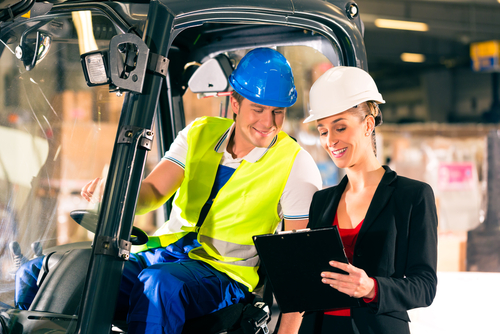In July 2014, California’s Division of Occupational Safety and Health (Cal/OSHA) leveled $308,435 in proposed fines against NFI, a warehouse operator in Mira Loma, California. What had NFI done to merit such a stiff penalty? The company had failed to correct conditions at its workplace that put pedestrians and forklifts together in dangerous ways.

When pedestrians and forklifts are working side by side, it is dangerous to both the pedestrians and the forklift operators. Here’s what you need to be aware of, and how you can prevent tragedy.
A Dangerous Combination
Each year, about 100 American workers die in forklift-related accidents, and another 20,000 are seriously injured. More than half those killed are pedestrians. How are pedestrians injured by forklifts?
- 25% of the fatalities are pedestrians that are crushed between the forklift and a hard surface, such as a wall, machine, equipment, etc.
- 11% of forklift-related fatalities are pedestrians that are crushed between two vehicles, one of which is a forklift.
- 10% of forklift-related fatality victims are pedestrians that are struck or run over by a forklift.
- 8% of forklift-related fatality victims are pedestrians that are struck by falling material or a falling load.
Does your organization use forklifts on the job? If so, having an effective forklift safety program is critical for protecting employees, assuring compliance, and minimizing damage to product and business assets. Click here to register for this webcast and learn more on forklift safety now!
Protecting Pedestrians
Forklift operators are covered by the training requirements of OSHA’s Powered Industrial Trucks standard, 29 CFR 1910.178—but what about pedestrians in the same workplace? They are not covered by any specific training requirement. You should be training them anyway. They need to understand that forklift operators may not see or hear them because they have:
Restricted visibility. Pedestrians need to know and understand that forklift operators may not be able to see or hear them. They should never assume that a forklift driver has seen them because:
- The forklift’s mast blocks quite a bit of the driver’s forward visibility, even when the forklift is not carrying a load.
- Forklifts have an overhead cage that protects the driver from falling loads. This cage has vertical supports that also block the driver’s vision.
- Forklifts carrying large loads have very restricted vision in front of them. Most of the time drivers will be going in reverse when carrying large loads so they can see where they are going. However, pedestrians still need to understand that their vision is limited.
- When going in reverse, drivers have to turn their head and their body to look behind them. This twisting and turning also reduces their vision.
- Although many forklifts have mirrors, drivers cannot rely on them because mirrors have blind spots.
Do you have an effective forklift safety program? Join us on October 9 for our upcoming webinar when our presenter will provide a clear understanding of what should be included in an effective and comprehensive program to assure employee safety and much more! Click here to register now!
Restricted hearing. Forklift drivers may not always hear warnings or shouts from pedestrians.
- The forklift’s engine is noisy, especially when the engine is revved up to raise the load or accelerate forward or backward.
- The forklift’s warning alarms, such as the back-up alarm and horn, reduce the driver’s ability to hear pedestrians.
- Other workplace noise from machinery, equipment, or other forklifts also restricts the driver’s ability to hear pedestrians.
Tomorrow, we’ll offer some specific pointers for pedestrians on how to stay clear of forklift hazards.
